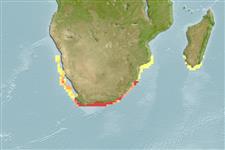Mixines (mixinos) (hagfishes) >
Myxiniformes (Hagfishes) >
Myxinidae (Hagfishes) > Eptatretinae
Etymology: Eptatretus: Greek, epta = seven + Greek, tretos, -e, -on = with holes (Ref. 45335).
Medioambiente / Clima / Gama
Ecología
; marino demersal; no migratorio; rango de profundidad 10 - 400 m (Ref. 36731), usually 10 - 45 m (Ref. 31276). Subtropical, preferred ?; 23°S - 35°S
Southeast Atlantic: known only from Walvis Bay, Namibia to Durban, South Africa.
Tamaño / Peso / Age
Maturity: Lm ? range ? - ? cm
Max length : 80.0 cm TL macho / no sexado; (Ref. 36731)
Commonly burrows in muddy bottoms (Ref. 27121). Feeds mostly by scavenging on dead or disabled fish (Ref. 27121).
Life cycle and mating behavior
Madurez | Reproducción | Puesta | Huevos | Fecundidad | Larva
Copulatory organ absent. The gonads of hagfishes are situated in the peritoneal cavity. The ovary is found in the anterior portion of the gonad, and the testis is found in the posterior part. The animal becomes female if the cranial part of the gonad develops or male if the caudal part undergoes differentiation. If none develops, then the animal becomes sterile. If both anterior and posterior parts develop, then the animal becomes a functional hermaphrodite. However, hermaphroditism being characterised as functional needs to be validated by more reproduction studies (Ref. 51361 ).
Fernholm, B., 1998. Hagfish systematics. p. 33-44. In J.M. Jørgensen, J.P. Lomholt, R.E. Weber and H. Malte (eds.) The biology of hagfishes. Chapman & Hall, London. 578 p. (Ref. 31276)
IUCN Red List Status (Ref. 115185)
CITES (Ref. 94142)
Not Evaluated
Threat to humans
Harmless
Human uses
Pesquerías: sin interés
Más información
Age/Size
Crecimiento
Length-weight
Length-length
Length-frequencies
Morfometría
Morfología
Larva
Dinámica larvaria
Reclutamiento
Abundancia
ReferenciasAcuiculturaPerfil de acuiculturaRazasGenéticaFrecuencias de alelosheritabilidadEnfermedadesProcesamientoMass conversion
ColaboradoresImágenesStamps, CoinsSonidosCiguateraVelocidadTipo de nataciónSuperficie branquialOtolitosCerebrosVisión
Herramientas
Special reports
Download XML
Fuentes de Internet
